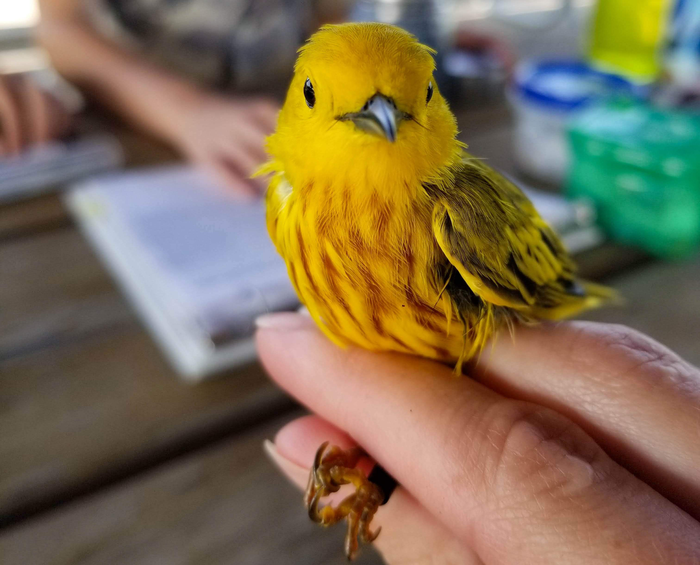Yellow warblers are hosts to brood parasitic brown-headed cowbirds, which rely on other species to raise their offspring. Warblers use referential “seet” calls to warn female warblers specifically of the brood parasitic brown-headed cowbirds that may try to lay eggs in their nests. When exposed to experimental playbacks of seet calls one day, female warblers were more vigilant the next morning, researchers report in the current issue of the journal Biology Letters.

Credit: Shelby Lawson
Yellow warblers are hosts to brood parasitic brown-headed cowbirds, which rely on other species to raise their offspring. Warblers use referential “seet” calls to warn female warblers specifically of the brood parasitic brown-headed cowbirds that may try to lay eggs in their nests. When exposed to experimental playbacks of seet calls one day, female warblers were more vigilant the next morning, researchers report in the current issue of the journal Biology Letters.
“Playback experiments are a powerful way to study the behaviors of birds in response to parasitic stimuli. Previously, these kinds of referential alarm calling experiments showed that yellow warblers do something specific right away when they hear the seet call,” said Mark Hauber, a professor of evolution, ecology, and behavior at the University of Illinois Urbana-Champaign, member of the Carl R. Woese Instiute for Genomic Biology and a fellow of the Wissenschaftskolleg zu Berlin.
Specifically, female warblers return to the nest and sit tightly after hearing a seet call. This defense mechanism prevents the brown-headed cowbird from inspecting the nest to plan when to lay her own egg in it and throwing warbler eggs out of the nest. However, cowbirds themselves only lay eggs in the minutes before sunrise and not during the daytime when most researchers have studied seet call responses.
“We wanted to see whether the warbler still remembers, a day later, that there is a potential parasitic threat to the nest and exhibits behaviors that are representative of protecting the nest from the parasite into the future,” said Hauber.
To investigate whether female warblers remembered the potential threat, researchers exposed yellow warblers to either seet calls, chip calls — an alert for predators —, or no playbacks (as controls). Observations were made using two methods: direct observation by research personnel and temperature loggers inside the warbler nests. The nests were left undisturbed by researchers from the time of playback to sunrise the next morning, said Hauber.
“We found that yellow warbler females who heard seet calls the previous day would sit on their nest for a longer period of time and would get off the nest fewer times compared to when they heard silence or the chip calls,” said Shelby Lawson, first-author of the study and a doctoral student in the Hauber lab. “They’re thinking of the cowbird the next morning even though the cowbird signal was the previous day.”
These behaviors suggest that the yellow warblers are possibly recalling past events — the seet calls — and engaging in mental time travel that boosts their nest attendance the next day. The alternative is a heightened state of alert lasting from the time of the playback call till the next morning, said Hauber.
“Our findings show the warblers may be doing something cognitively advanced to be able to think of the threat the next day,” said Lawson. “We don’t know mechanistically what’s going on in their head when they hear the seet call and so we have future studies planned to measure brain activity as we play different sounds.”
###
Other co-authors of the paper include Janice Enos, Caroline Wolf, Katharine Stenstrom, Sarah Winnicki, Thomas Benson and Sharon Gill. For more info, please visit: www.cowbirdlab.org
Funding was provided by the American Ornithological Society, the Illinois Ornithological Society, the National Geographic Society, the School of Integrative Biology at the University of Illinois Urbana-Champaign, and the National Science Foundation.
Journal
Biology Letters
DOI
10.1098/rsbl.2021.0377
Subject of Research
Animals
Article Title
Referential alarm calling elicits future vigilance in a host of an avian brood parasite
Article Publication Date
15-Sep-2021




